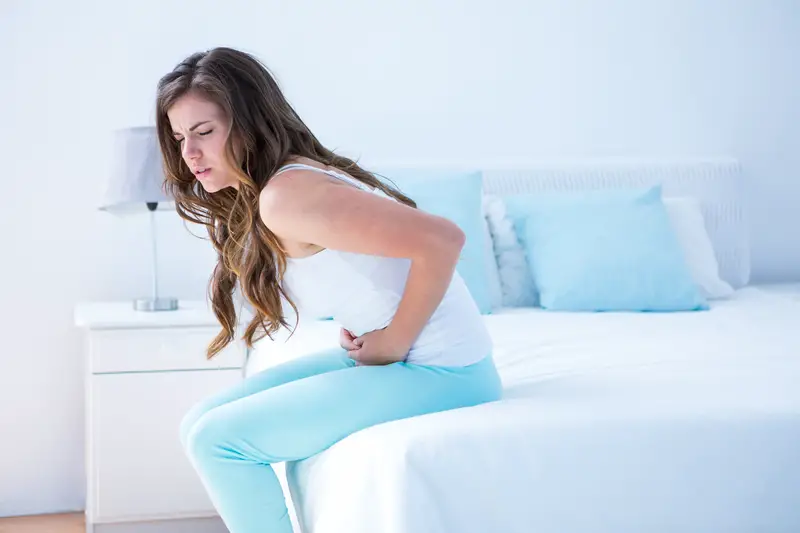In this article, we sit down with Dr. Yuan, a Traditional Chinese Medicine (TCM) doctor, to discuss a natural way to relieve one of the most common symptoms of irritable bowel syndrome (IBS): constipation. As a chronic condition that affects millions of people worldwide, it’s essential to find effective treatment options that can improve your quality of life. Acupuncture for constipation is a promising alternative to traditional medication, and it’s gaining popularity among those seeking natural remedies. In this guide, we will explore the benefits of self-acupuncture for constipation and how it can provide relief from IBS’s painful symptoms in the comfort of your home.
Understanding Acupuncture for IBS Constipation
How Does Acupuncture for IBS Constipation Work?
IBS is a disorder that affects the gastrointestinal tracts (the intestines and stomach). A person with IBS often experiences frequent abdominal pain, bloating, and changes in their bowel movements—constipation, diarrhea, or sometimes, both—from intestinal spasms and the gastrointestinal tract’s hypermotility.
The bad news is that IBS often persists throughout the person’s life and cannot be cured. Additionally, the medical community is yet to find the cause of this unfortunately common and painful chronic condition. Patients are diagnosed based on symptoms alone and these can be either mild or severe.
The good news is that IBS can be managed. Additionally, the symptoms don’t cause any other disease or damage in your gastrointestinal tract, nor do they increase the risk of developing other conditions related to your digestive system (such as cancer).
Acupuncture helps alleviate symptoms of IBS by helping the nervous system release hormones and chemicals that can relieve the stress and pain caused by IBS symptoms.
Studies show that after undergoing acupuncture treatment, the speed of the colonic peristalsis and the frequency of bowel sounds significantly increased, showing that this treatment method can regulate colonic peristalsis in IBS-C (constipation-predominant IBS) patients.
Research also details that electrical stimulation via electroacupuncture can greatly improve severe constipation, increasing the frequency of bowel movements to three or more per week, whereas those who didn’t receive the treatment continued to face IBS constipation issues.
Acupuncture also presents a safe way for patients to try relieving symptoms on their own while also allowing the space for other treatment options such as diet changes, traditional medications, and exercise if desired.
Can Acupuncture Help with Bowel Problems Such as Constipation?
According to Dr. Yuan, Acupuncture for constipation is highly effective—more than drugs, according to some studies. He said this with utmost certainty from personal experience as well as years of having treated patients’ IBS-induced constipation with acupuncture.
Can Self-Acupuncture Be Effective in Relieving Constipation?
Yes. With sufficient training and knowledge, patients can practice self-acupuncture to relieve constipation, according to Dr. Yuan. It’s easy, effective, and, most importantly, safe.
Even if they may not be able to hit as many acupoints as a trained traditional Chinese medicine (TCM) practitioner, they will experience a great amount of relief if self-acupuncture is done safely and correctly.
Acupuncture Points for Constipation
Based on Dr. Yuan’s experience, these 6 acupressure points are the most commonly used for constipation.
Acupoint: TE-6 (Other Names: Triple Energizer-6/Zhi Gou/Branch Ditch)
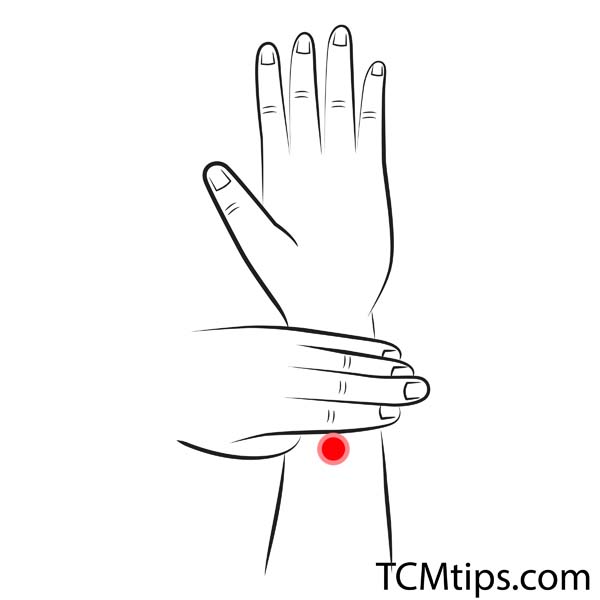

Where is TE-6 acupuncture point?
- Extend your arm with your palm facing down.
- Look at your forearm and identify two long bones: one on the thumb side (radius) and one on the pinky side (ulna).
- Locate your wrist line or crease, where your hand meets your forearm.
- Measure approximately 3 cun below the wrist line towards your elbow.
- At this point, you will find a slight groove or depression between the radius and ulna bones on the thumb side of your forearm.
- The TE-6 point is located in this groove.
Acupoint: ST-25 (Other Names: Stomach-25/Tian Shu/Celestial Pivot)
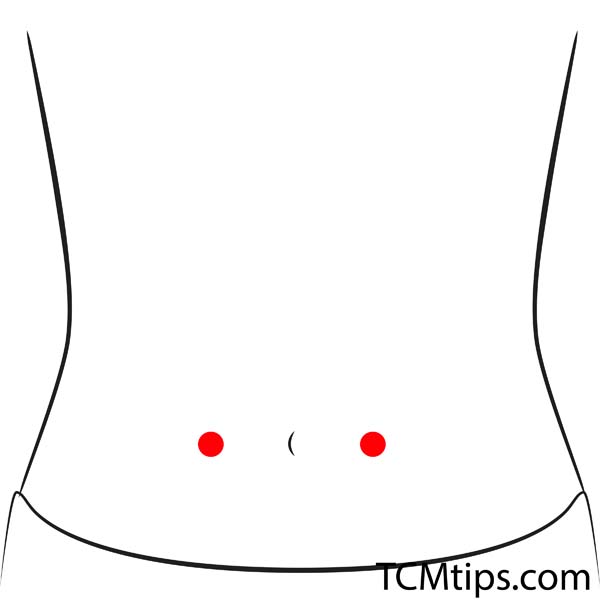
Where is ST-25 acupuncture point?
- Stand upright and locate your navel (belly button).
- Place the tips of your three fingers (excluding the thumb) horizontally on one side of your navel, with the index finger touching the edge of the navel.
- The width of these four fingers is approximately 2 cun.
- The ST-25 point is located 2 cun directly to the side of your navel, either on the left or right side.
Acupoint: ST-36 (Other Names: Stomach-36/Zu San Li/Leg Three Miles)
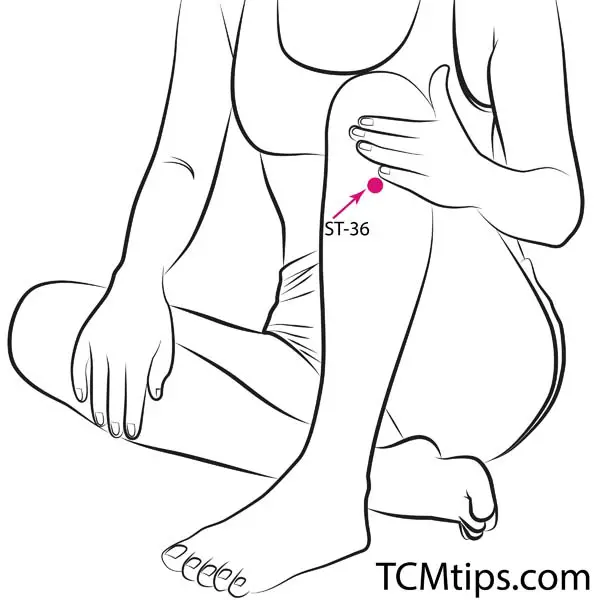
Where is St-36 acupuncture point?
- Sit or stand with your legs slightly apart and your knees exposed.
- Place the tips of your four fingers (excluding the thumb) immediately below your kneecap on one of your legs, with your index finger touching the lower edge of the kneecap.
- Now, move your hand about one finger-breadth (the width of your finger) to the outside of your shinbone (tibia), away from the anterior crest or ridge-like structure on the front of the shinbone.
- The ST-36 point is located at this spot, which is about four finger widths below the kneecap and one finger-breadth to the outside of the shinbone’s anterior crest.
Acupoint: ST-37 (Other Names: Stomach-37/Shang Ju Xu/Upper Great Void)
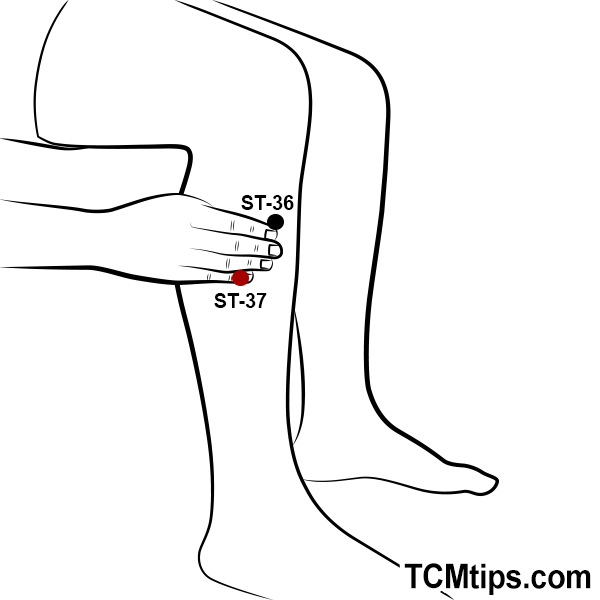
Where is ST-37 acupuncture point?
- First, locate ST-36. You can check the description above.
- From the ST-36 point, measure about 3 cun down towards your ankle along the front of your leg.
- The ST-37 point is located at this spot, which is about 3 cun below ST-36 and still about 1 finger width to the outside of the shinbone.
Acupoint: Ren-6 (Other Names: The Conception Vessel-6/Qi Hai/Sea of Qi)
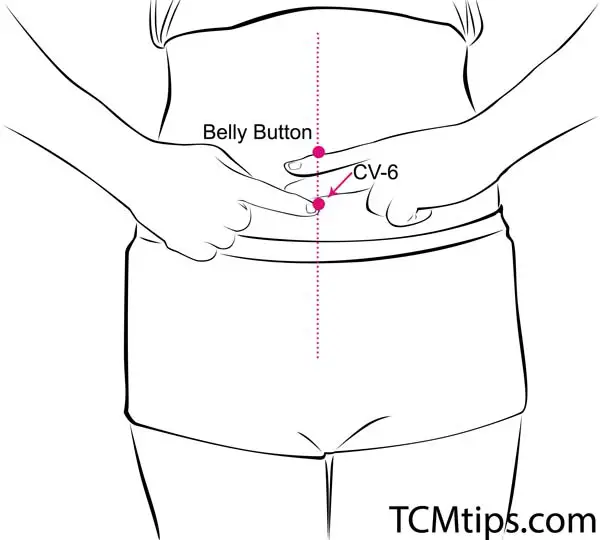
Where is Ren-6 acupuncture point?
- Stand or sit upright and locate your navel (belly button).
- Measure approximately 2 cun directly below the navel, along the midline of your abdomen.
- Alternatively, you can also locate the pubic symphysis, which is the joint where the two pubic bones meet in the lower part of your pelvis.
- Measure approximately 3.5 cun directly above the pubic symphysis, along the midline of your abdomen.
- The Ren-6 point is located at the intersection of these two measurements along the midline of your abdomen.
Acupoint: Ren-12 (Other Names: The Conception Vessel-12/Zhong Wan/Middle Epigastrium)
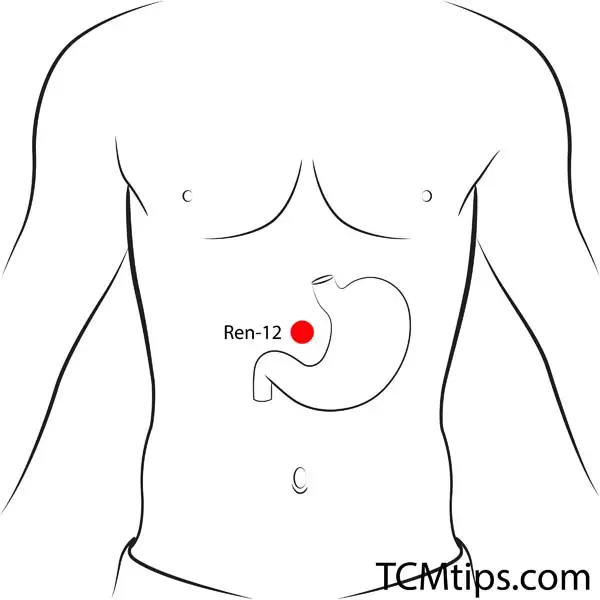
Where is Ren-12 acupuncture point?
- Stand or sit upright and locate your navel (belly button).
- Measure approximately four cun directly above the navel, along the midline of your abdomen.
- The Ren-12 point is located at this spot, on the midline of your abdomen.
For more information about using acupressure points for constipation, please check out our other article.
Acupuncture for Constipation Reviews or Success Stories
Dr. Yuan has used a combination of acupuncture and moxibustion (where he burns the leaves of a spongy, small herb known as mugwort to enhance healing).
Moxibustion and acupuncture consider the human body as a tiny universe in itself, the components of which are interconnected by various tiny channels.
When used together, moxibustion and acupuncture stimulate these connecting channels and support and promote the body’s self-regulating functions, enhancing overall health. The combination is especially effective against IBS-D (where diarrhea is predominant).
By stimulating the points mentioned above on himself and his patients, he has seen significant success in alleviating IBS-induced constipation and can guarantee the efficiency of acupuncture for chronic constipation.
Most patients who follow this treatment on alternate days, for a total of at least 20 sessions, face excellent results.
Frequently Asked Questions
What Can a Person Expect During Acupuncture Treatment for Constipation?
When undergoing acupuncture treatment for constipation, patients can hear their bowel sounds increase and even their abdominal cramps fade away slowly. In addition, the feeling of fullness that constipation brings can also fade away, according to some patients.
How Long Does It Typically Take for Acupuncture to Work for Constipation?
As mentioned earlier by Dr. Yuan, at least 20 sessions on alternate days are required when undergoing acupuncture for constipation for most patients. However, if you’re doing it on consecutive days, at least a month of consistent treatment will show satisfactory results.
How Many Acupuncture Sessions Are Typically Needed to See Improvement in Constipation Symptoms?
This depends on the patient. Some patients are extremely sensitive to acupuncture treatments and can feel relief from the very first session itself. For most others, it took about 20 sessions, twice or thrice a week, to feel a noticeable difference.
General Advice from Dr. Yuan on Using These Acupuncture Points for Constipation
If the abdomen is loose, moxibustion makes for a better-accompanying treatment, and if the abdomen tenses, electroacupuncture is a better acupuncture for constipation treatment.
Key Takeaways
Here are some key takeaways for those looking to treat their IBS systems at home with acupuncture:
- There are 13 acupressure points on the body that can be treated for relief from constipation. Acupuncture stimulates these points to release hormones and chemicals that can alleviate symptoms.
- The six main points that are usually treated are Zhi Gou TE6, Tian Shu ST25, Shang Ju Xu ST37, Qi Hai Ren6, Zhong Wan Ren12, and Zu San Li ST36.
- It takes at least 20 sessions, done twice or thrice a week, or a month of consistent treatment, to see significant results. However, some sensitive patients may feel relief after the first session itself.
- Acupuncture for constipation can be accompanied by moxibustion for better results. With some patients, electroacupuncture may be used.
- Self-acupuncture for constipation is only effective when done safely and correctly. It’s important to learn from a licensed TCM practitioner what you should and shouldn’t do before attempting this by yourself at home.
- We strongly advise against untrained individuals attempting acupuncture at home with needles, as it can be dangerous and potentially cause harm. Instead, we recommend self-acupuncture for constipation or acupressure techniques, which can be performed safely at home. It is important to note that if you experience severe constipation, it is essential to seek medical attention and consult with a licensed acupuncturist before attempting any form of self-treatment. However, with caution and care, self-acupuncture for constipation can effectively manage your symptoms and improve your overall well-being.

Try our Anti-Aging Gua Sha Tool designed to bring out your skin’s natural glow.
Best Gua Sha Product- Anti-Aging: The tool is designed to target 11 specific aging signs such as wrinkles and sagging skin. By following the 7-step routine, users can improve skin firmness and reduce fine lines naturally.
- Enhances Skincare Routine: It works effectively with serums and lotions, boosting absorption and efficacy of skincare products.
- Visible Skin Improvement: Users can expect a smoother complexion, reduced puffiness, and a more youthful appearance.
 P. Sze
P. Sze 